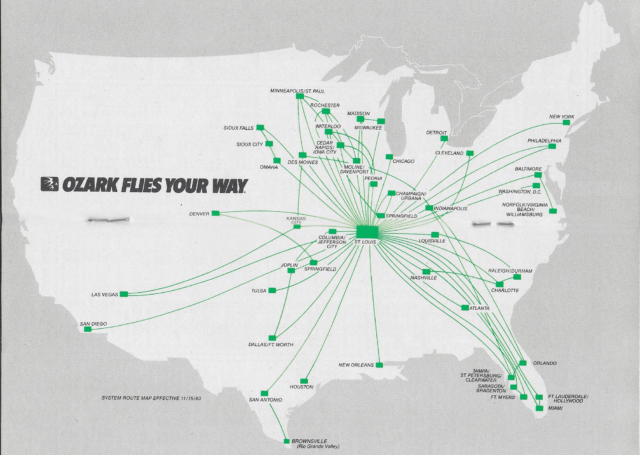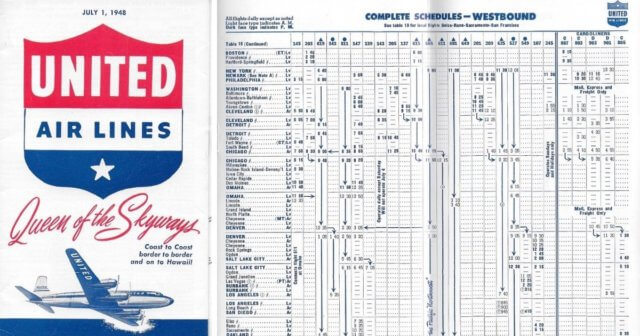
What’s happening with airports across the country as airlines deal with staffing shortages, capacity constraints, and delayed and canceled flights is nothing new to Iowa’s smaller-commercial airports. In a three-part series, Twitter user @AirspaceIowa will explain what’s been hindering Iowa’s smaller airports and what it means for their future.
Read Part One: https://iowastartingline.dream.press/2022/06/29/iowa-small-market-airline-service-continues-decline-part-one/
Read Part Two: https://iowastartingline.dream.press/2022/06/30/the-rise-and-fall-of-iowas-small-market-airline-service-part-two/
Part 3: New connections and disappearing services
During the regulated era, Ozark Airlines, based in St. Louis, provided local service for many small and large Iowa communities (Ozark was eventually acquired by TWA in 1986). There were other local service airlines, such as North Central and Mid-Continent, but Ozark was the more dominant local service airline in this part of the Midwest.


At the time, local airline service was more like local train service, with often one or two (and sometimes even more) intermittent stops between your origin and destination. It wasn’t as efficient as flying to a hub city and connecting to a new flight to your final destination, and it was also much more expensive.
Before deregulation, air travel (especially to the coasts or out of the country) was out of reach for your average citizen. But fares were based more on the length of the flight as opposed to demand, so regional flights were more affordable than longer flights. And you could actually travel from one part of the state to another on an airplane.
Local airline service, along with the development of the Interstate Highway System, both contributed to the demise of privately-owned passenger trains. And unfortunately, it didn’t take long after private train travel ended for airlines to shift away from the local service model to the hub and spoke model, which is more efficient for distances of 500 miles or more. It also means automobile transportation is the primary means of intercity transportation in areas such as the Midwest, West, and South with high population dispersion.

These changes to the national airline system have certainly made it easier for anyone to travel by air across different regions of the country, for business or pleasure. But they’ve also consolidated air travel to be most convenient from medium and large size cities, leaving small towns and rural areas with minimal service.
Rural markets do have the Essential Air Service option–Federal Government-subsidized airline service. It’s a throw-back to pre-deregulation in that it provides direct payments to specific airlines to fly a specific route with a specific frequency. The maximum subsidy within the lower 48 states is roughly $1,000 per passenger (although most markets receive substantially less), and both Hawaii and Alaska markets are exempt from the subsidy limitation owing to their unique geographies.
Of the five Iowa markets losing service, four are EAS cities (Dubuque is the only one that’s not). Typically these are markets 90 minutes or more drive-time away from the nearest airline-served airport. But EAS schedules are not typically as robust or as expansive as airlines choosing to serve a market on their own—and often they’re on very small aircraft, which while being perfectly safe and a unique experience in their own right, make some passengers uncomfortable. By definition, EAS only serves markets deemed “essential,” yet that don’t have enough demand potential for airlines to serve on their own.
And honestly, maybe that’s fine? Consolidation of population in larger cities has been the norm since after World War II, so none of these trends are a surprise to anyone reading this. For most people in rural areas, driving 1-2 hours each way a few times a year to fly is not a significant hurdle, and with airfares still mostly affordable (especially thanks to ULCC airlines), more people can afford to fly than ever before.
But the reduction in air service for rural areas can be a significant hurdle for increased development, especially when it comes to convenient business travel access and development of new industries/companies. Despite the significantly increased usage of video conferencing, many businesses still depend on actual people traveling from one place to another, either for face-to-face interactions with clients or for immediate problem-solving. Private air transportation can mitigate this somewhat, but it’s very expensive and significantly resource intensive.
The bottom line is that in the current environment, without continued federal support of rural airline service, small city access to convenient nationwide transportation would disappear—a similar consequence for small cities and towns if rural mail service was privatized.
To survive and grow, small markets, in particular, need more robust service and more convenient schedules than they have today; without it, small/rural markets will continue to struggle when it comes to attracting development opportunities requiring convenient access to airline travel.
by @AirspaceIowa
07/01/22
Iowa Starting Line is part of an independent news network and focuses on how state and national decisions impact Iowans’ daily lives. We rely on your financial support to keep our stories free for all to read. You can contribute to us here. Also follow us on Facebook and Twitter.
